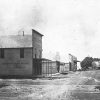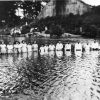calsfoundation@cals.org
William Stevenson (1768–1857)
William Stevenson was a nineteenth-century preacher generally credited with bringing Methodism to Arkansas. A prototypical frontier preacher and circuit rider, he moved from frontier region to frontier region—from the South Carolina frontier to Tennessee, from there to Missouri, and from there to Arkansas—until he finally settled in Louisiana. Swept into the enthusiastic Methodism of the Second Great Awakening, he felt a desire to spread the faith that led him into sparsely settled areas. In doing so, he laid the foundations of the Methodist faith in Arkansas.
William Stevenson was born on October 4, 1768, in a frontier area of South Carolina, not far from the line marking Cherokee land. His parents, James Stevenson and Elizabeth Stevenson, were Presbyterian, and he was baptized into that church as an infant. While Stevenson was still a child, his mother converted to the Baptist faith. At the age of twenty, he heard a Methodist preacher for the first time. He did not convert to Methodism, however, until 1800, after considerable further exposure to Methodist preaching.
In 1809, Stevenson—with his wife, Jane Stevenson, and their eight children—moved to Bellevue Valley, Missouri. He purchased 240 acres there and became an important figure in the community. He lived there during the New Madrid Earthquakes of 1811–1812 and wrote one of the earliest first-hand accounts of that event. In 1815, he ran unsuccessfully against Stephen F. Austin for a seat in the General Assembly of the Missouri Territory.
By that time, he had already visited Arkansas on a preaching tour. He was ordained as a deacon in 1813 by the Tennessee Conference. A visit from his brother, James, then living in Arkansas, prompted Stevenson to embark on a short preaching tour to the Forte Caddo branch of the Ouachita River and Mound Prairie (Hempstead County) in 1813–14. In 1815, he visited the Arkansas River and Red River valleys; in the latter, he engaged in the first Methodist preaching in Texas.
The next year, he moved to Mound Prairie. In 1817, he was appointed by the Methodists’ Missouri Conference as a circuit rider, along with John Harris, for the Hot Springs Circuit—all of Arkansas south of the Arkansas River. From 1818 to 1825, he served as a presiding elder in Arkansas, except for a couple of years in which he suffered from poor health. His ministry reached out to frontier families over a large area of Arkansas, often traveling through difficult conditions. Most of his work was with white settlers, though he did record small numbers of black and native Methodist converts. Stevenson’s leadership of Arkansas Methodism was highly energetic; Methodist ministries in Arkansas shrank after Stevenson relocated to Louisiana in 1826.
Stevenson was also involved in early Arkansas politics. He was elected as the representative for Hempstead County to the first General Assembly of the Arkansas Territory in 1820. He was chosen to serve as speaker of the assembly but resigned that position after only a single day for reasons that are unclear, though he continued to remain active in the assembly. It was Stevenson who proposed the motion to make Little Rock (Pulaski County) the capital of the territory.
In 1826, Stevenson moved to Louisiana. The move may have been precipitated by the appointment of the Reverend Jesse Hale as presiding elder of the Arkansas District in 1825. Hale sought to enforce Methodist rules regarding slave ownership, specifically the provisions stating that slave owners could not hold any church office. The controversy that resulted may have precipitated Stevenson’s move. Stevenson may also have noted the lack of Methodist preachers in northern Louisiana. Whatever his motivation, he lived in Louisiana until his death on March 5, 1857, in Claiborne Parish. He is buried in a family plot about six miles east of Homer, Louisiana.
For additional information:
Britton, Nancy. Two Centuries of Methodism in Arkansas. Little Rock: August House, 2000.
Stevenson William. The Autobiography of the Rev. William Stevenson. Edited by Ted A. Campbell. Dallas: Tuckapaw Media, 2012. Online at http://www.smu.edu/~/media/Site/Perkins/PDF/PublicProgs/LaySchool/
Autobiography%20of%20William%20Stevenson.ashx (accessed October 6, 2021).
Vernon, Walter. William Stevenson: Riding Preacher. Dallas: Southern Methodist University Press, 1964.
Michael Johnson
Northwest Arkansas Community College
 Louisiana Purchase through Early Statehood, 1803 through 1860
Louisiana Purchase through Early Statehood, 1803 through 1860 Ozan (Hempstead County)
Ozan (Hempstead County) Religion
Religion




Nice to find this. My wife is a great-great-great-great-granddaughter of Rev. Stevenson. 🙂
My book Two Centuries of Methodism in Arkansas, published by the Arkansas Conference and August House Publishing in 2000, has quite a few entries on Stevenson. My favorite is found on p. 29 of the book. The original source for the quote was G. W. Featherstonhaugh [pronounced Fan-shaw] in his book An Excursion Through the Slave States, p. 46. Featherstonhaugh was a visiting Englishman who passed through Little Rock in 1834. Here is just a part of his recollection of Stevenson:
At length we heard of a clergyman who lived on the skirts of the town, and sometimes took in boarders, so we immediately hied to the Rev. Mr. Stevensons. It was a nice-looking cottage enough, separated from the road by a paling, inside of which was standing a somewhat dried-up looking individual, in a seedy-looking, light-coloured jacket, an old hat with a broken rim on his head, only one eye in that, and a rifle in his hand. Pray, Sir, said I, touching my hat, can you inform me if this is the Reverend Mr. Stevensons? Upon which he immediately said I expect I am the Reverend Mr. Stevenson.
It is known that Stevenson had suffered a serious eye injury as a child, and had lost the vision in that eye.